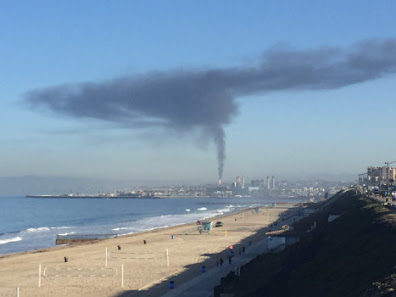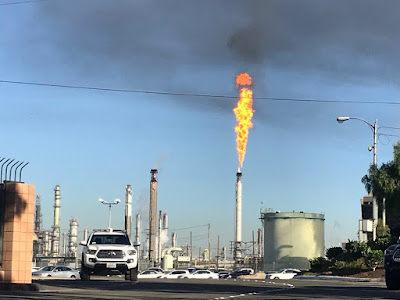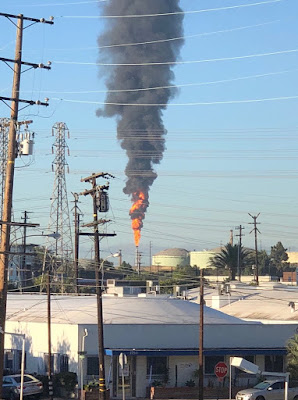Chevron’s El Segundo refinery has operated for over a century as one of the largest refineries on the West Coast, processing more than 270,000 barrels of crude oil per day. Located only a few miles from Los Angeles International Airport and surrounded by dense residential neighborhoods, the refinery has long drawn attention for visible burn-offs or flaring events that light up the skyline. These planned and unplanned flares, sometimes producing massive smoke plumes, are safety measures designed to burn off excess hydrocarbons rather than release them directly into the atmosphere. Yet the frequency, scale, and community impact of these burn-offs have raised questions about environmental oversight, transparency, and health risks.
What Is a Burn-Off or Flare?
At its most basic, a flare is a tall stack designed to combust excess gas. Refineries use flares to manage hydrocarbons during system upsets, startup or shutdown operations, maintenance activities, or unexpected power failures. Instead of venting gases directly, which would release volatile organic compounds and toxic hydrocarbons, flares convert much of the gas into carbon dioxide and water. While this reduces the severity of emissions, incomplete combustion still produces pollutants such as soot, particulates, sulfur dioxide, nitrogen oxides, and benzene. Planned flares may be scheduled and announced, while unplanned flares occur suddenly in response to equipment failures, power loss, or process imbalance.
September 17, 2018 Burn-Off Event
One of the most visible flaring incidents occurred on September 17, 2018, when a large plume of thick black smoke towered over El Segundo. The smoke, visible for miles across Los Angeles, alarmed residents and commuters who feared a refinery fire. Chevron later confirmed that the burn-off was triggered by a power outage and was a safety measure to relieve process gases. Officials insisted it was not an uncontrolled fire but a controlled flare. Still, the visuals of massive black plumes raised concern about air quality and the transparency of notifications to the public.
Historical Frequency of Flaring at El Segundo
Chevron’s El Segundo facility has flared for decades, both as part of routine operations and in response to system problems. Regulatory filings with the South Coast Air Quality Management District (SCAQMD) show that flare events occur multiple times per year. In October 2009, Chevron reported flaring during maintenance on its Isomax hydrocracking unit. In December 2012, the company notified regulators of a 24-hour flare event planned to begin at 6 a.m. during maintenance. In August 2021, residents reported visible flares lighting up the night sky after a compressor failure. In May 2025, Chevron disclosed an unplanned flaring event to regulators. These events, along with the 2018 power-loss flare and numerous smaller events in between, show that flaring is not rare but a recurring part of refinery operations.
Why Flaring Happens
Several scenarios explain why Chevron must flare gases. Planned flaring occurs during unit shutdowns for maintenance, when hydrocarbons in the system must be purged safely. Startups following repairs also generate unstable gas flows that require flaring. Power outages, such as in 2018, can shut down compressors and pumps, forcing gases to be diverted to flares to prevent over-pressurization. Equipment malfunctions, like valve failures or compressor trips, also lead to sudden flaring. The refinery’s complex systems, operating under high temperature and pressure, mean that even small upsets can cascade quickly without flares as safety relief.
Community Concerns and Perceptions
For residents of El Segundo and neighboring cities such as Manhattan Beach and Hawthorne, flares are highly visible reminders of refinery risks. Black smoke columns or bright nighttime flames can be alarming, particularly when information is scarce. Health concerns are also common, as flares can release particulate matter, benzene, sulfur compounds, and other irritants. Short-term exposure may cause headaches, throat irritation, or respiratory issues, while long-term cumulative exposure is harder to measure. The visual impact of frequent flaring has also eroded trust, with many community members questioning whether Chevron provides adequate notice, monitoring, and mitigation.
Regulatory Oversight and Rule 1118
Flaring at El Segundo is regulated under SCAQMD Rule 1118, which requires refineries to monitor, report, and minimize flaring. Refineries must file quarterly reports detailing flare emissions and event frequency. The SCAQMD’s Flare Event Notification System (FENS) allows public access to records of flaring activity. Rule 1118 also limits visible emissions and opacity of flare smoke, penalizing exceedances. Despite these measures, critics argue enforcement is inconsistent and penalties are insufficient to deter repeated events. Chevron maintains that flares are integral safety devices, but environmental groups counter that their frequency signals underlying inefficiencies or maintenance issues.
Historical Accidents Linked to Flaring and Fires
While flaring is distinct from uncontrolled refinery fires, the two often coincide. In 1986, a fire in Chevron’s diesel hydrofiner unit produced dense black smoke across Los Angeles. In November 2022, a fire broke out at the refinery in the evening, requiring hours to contain and triggering safety flares in the process. In October 2025, a significant fire and explosion again resulted in flaring as emergency systems activated. These incidents illustrate how flaring is both a planned activity and a last line of defense during emergencies.
Chevron El Segundo Refinery Flaring Timeline
| Year | Event | Description |
|---|---|---|
| 2009 | Planned flare | Chevron reported flaring tied to Isomax hydrocracking unit maintenance. |
| 2012 | Scheduled flare | Regulatory filing noted ~24-hour flare beginning at 6 a.m. during planned maintenance. |
| 2018 | Power outage flare | September 17: major plume of black smoke visible for miles; Chevron said it was triggered by a power loss and not a fire. |
| 2021 | Compressor failure flare | August: residents observed large flames and smoke from a flare after equipment malfunction. |
| 2022 | Fire + flare | November: evening fire burned for hours; safety flares were activated during emergency shutdown. |
| 2025 (March) | Unplanned flare | Reported flare following an upset, confirmed in filings. |
| 2025 (May 18) | Unplanned flare | Chevron reported another flare event due to equipment or process upset. |
| 2025 (October 3) | Fire + emergency flaring | A major refinery fire and explosion triggered safety flare activity. |
Risks of Frequent Burn-Offs
The repeated reliance on flaring at El Segundo raises several risks. First, incomplete combustion during flares can release harmful pollutants into nearby neighborhoods. Second, frequent flaring suggests ongoing operational stresses such as aging equipment, high utilization, or inadequate redundancy in process systems. Third, cumulative emissions from frequent flaring contribute to local air quality problems in communities already burdened by industrial pollution and freeway traffic. Finally, the lack of timely communication during flare events leaves residents vulnerable to misinformation and fear.
Recommendations for Safer Practice
To reduce risks and improve community trust, several steps can be taken. Chevron should minimize flare frequency through process optimization, redundant systems, and predictive maintenance. Advance notification systems, such as text or email alerts, should be expanded to nearby residents ahead of planned flares. Continuous emissions monitoring should be installed at fence lines and data made publicly available in real time. Regulators should increase enforcement of opacity limits and penalize excessive flare duration or frequency. Community forums and transparency initiatives can help rebuild trust and address concerns directly.
FAQ: Chevron El Segundo Flaring Events
How often does flaring happen at Chevron El Segundo? Regulatory filings show multiple events each year, both planned and unplanned, with frequency varying by maintenance schedules and equipment upsets.
Why does Chevron flare gases? Flares are used during maintenance, startups, shutdowns, power failures, or equipment malfunctions to safely burn excess hydrocarbons.
Are flares dangerous? Flares reduce risk by burning gases, but incomplete combustion can release pollutants like soot, benzene, and sulfur oxides, impacting air quality.
How are flares regulated? Under SCAQMD Rule 1118, Chevron must report flare events, monitor emissions, and minimize flaring, though critics say enforcement is weak.
Do residents get notified? Chevron sometimes notifies regulators and publishes reports, but many community members say real-time alerts and transparency remain insufficient.
Conclusion
Chevron’s El Segundo refinery, a century-old giant of Southern California’s oil industry, continues to rely on flaring and burn-offs as routine safety measures. While these flares serve as essential pressure relief systems, their frequency and visibility have long unsettled nearby communities. Historical records show flare events in 2009, 2012, 2018, 2021, 2025, and many more, proving they are not rare exceptions but a persistent feature of refinery operations. The challenge lies not in eliminating flares altogether but in minimizing their occurrence, improving combustion quality, and ensuring residents are informed and protected. As environmental regulations tighten and communities demand accountability, Chevron’s ability to manage flaring responsibly will be central to its future in El Segundo. The refinery may view flares as a safety tool, but for residents, they are a constant reminder of the risks of living next to one of the largest oil processing facilities on the West Coast.
UPDATE: El Segundo Fire Department says Chevron Refinery burn-off was not planned - it was reaction to power failure https://t.co/R44KZgRISf pic.twitter.com/QWHthV5qG2— ABC7 Eyewitness News (@ABC7) September 17, 2018




